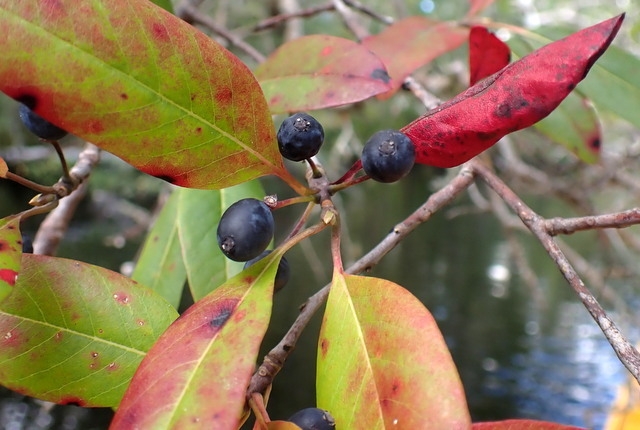Swamp Tupelo
(Nyssa biflora)
Swamp Tupelo (Nyssa biflora)
/
/

mfeaver
CC BY 4.0
Image By:
mfeaver
Recorded By:
Copyright:
CC BY 4.0
Copyright Notice:
Photo by: mfeaver | License Type: CC BY 4.0 | License URL: http://creativecommons.org/licenses/by/4.0/ | Rights Holder: mfeaver | Publisher: iNaturalist | Date Created: 2023-10-09T11:32:35-07:00 |
























Estimated Native Range
Summary
Nyssa biflora, commonly known as Swamp Tupelo, is a deciduous tree native to the southeastern United States. It is specifically adapted to wetland habitats, including deep swamps, pond margins, and river bottoms, often where standing water persists. Swamp Tupelo is found from Delaware to Florida and west to Texas, extending north along the Mississippi Valley to Illinois. It typically grows to a height of 30-50 feet (9-15 meters) but can reach up to 98 feet (30 meters) under ideal conditions. The tree has a narrow, columnar form with a straight trunk and a rounded crown. Its leaves turn a vibrant yellow to orange-red in the fall, adding seasonal interest.
Swamp Tupelo is valued for its ability to thrive in wet conditions and its ecological role in supporting wildlife. It produces small, greenish-white flowers in the spring that are not particularly showy but are beneficial to pollinators. By fall, the tree bears dark blue drupes that provide a food source for birds and other animals. In cultivation, it is used for reforestation in wet areas and as a specimen tree in large landscapes. It requires consistently moist to wet soil and full sun to part shade. While it is not commonly found in the nursery trade, it can be a unique addition to native plant gardens or naturalized areas. Swamp Tupelo is generally free of serious pests and diseases, but it is not tolerant of drought or urban pollution.CC BY-SA 4.0
Swamp Tupelo is valued for its ability to thrive in wet conditions and its ecological role in supporting wildlife. It produces small, greenish-white flowers in the spring that are not particularly showy but are beneficial to pollinators. By fall, the tree bears dark blue drupes that provide a food source for birds and other animals. In cultivation, it is used for reforestation in wet areas and as a specimen tree in large landscapes. It requires consistently moist to wet soil and full sun to part shade. While it is not commonly found in the nursery trade, it can be a unique addition to native plant gardens or naturalized areas. Swamp Tupelo is generally free of serious pests and diseases, but it is not tolerant of drought or urban pollution.CC BY-SA 4.0
Plant Description
- Plant Type: Tree
- Height: 60-100 feet
- Width: 20-40 feet
- Growth Rate: Slow, Moderate
- Flower Color: Green, White
- Flowering Season: Spring, Summer
- Leaf Retention: Deciduous
Growth Requirements
- Sun: Full Sun, Part Shade
- Water: High
- Drainage: Medium, Slow
Common Uses
Bird Garden, Erosion Control, Low Maintenance, Water Garden
Natural Habitat
Native to deep swamps, pond margins, and river bottoms in the southeastern United States
Other Names
Common Names: Swamp Tupelo, Water Gum, Black Gum
Scientific Names: , Nyssa biflora, Nyssa biflora var. ursina, Nyssa servatilis, Nyssa sylvatica subsp. biflora, Nyssa sylvatica var. biflora, Nyssa sylvatica var. ursina, Nyssa ursina,
GBIF Accepted Name: